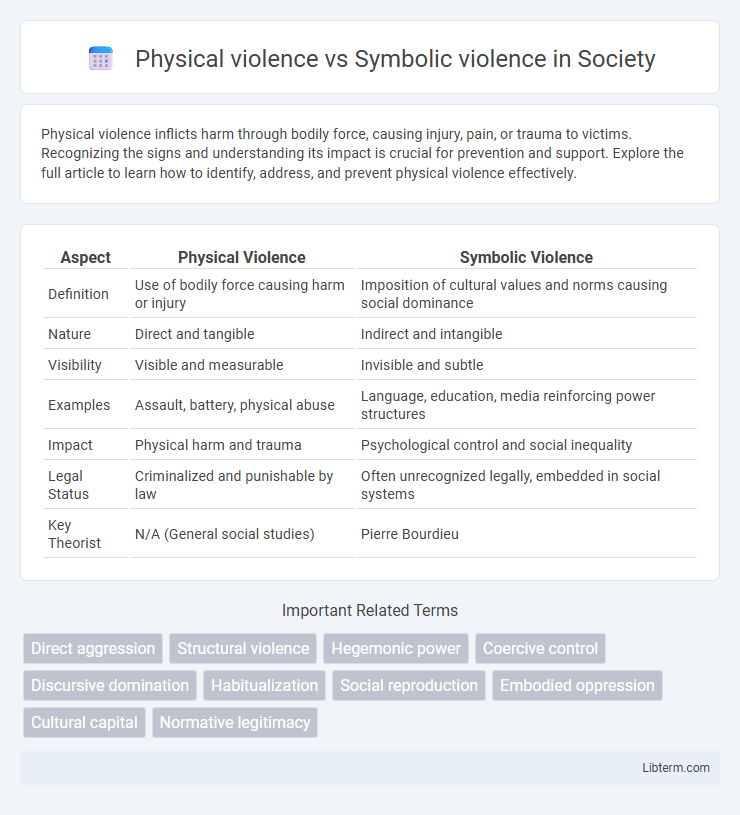Physical violence inflicts harm through bodily force, causing injury, pain, or trauma to victims. Recognizing the signs and understanding its impact is crucial for prevention and support. Explore the full article to learn how to identify, address, and prevent physical violence effectively.
Table of Comparison
| Aspect | Physical Violence | Symbolic Violence |
|---|---|---|
| Definition | Use of bodily force causing harm or injury | Imposition of cultural values and norms causing social dominance |
| Nature | Direct and tangible | Indirect and intangible |
| Visibility | Visible and measurable | Invisible and subtle |
| Examples | Assault, battery, physical abuse | Language, education, media reinforcing power structures |
| Impact | Physical harm and trauma | Psychological control and social inequality |
| Legal Status | Criminalized and punishable by law | Often unrecognized legally, embedded in social systems |
| Key Theorist | N/A (General social studies) | Pierre Bourdieu |
Understanding Physical Violence: Definition and Forms
Physical violence refers to the intentional use of force or power against an individual that results in bodily injury, pain, or impairment, encompassing actions such as hitting, slapping, punching, kicking, or the use of weapons. It manifests in various forms including domestic violence, assault, child abuse, and homicide, each characterized by distinct patterns and contexts of aggressive behavior. Understanding physical violence requires recognizing both overt acts of aggression and the underlying motives that drive such behavior, as well as the significant physical and psychological consequences for victims.
What Is Symbolic Violence? Exploring the Concept
Symbolic violence refers to the subtle, often invisible forms of coercion and domination embedded in cultural norms, language, and social practices that perpetuate inequality without physical force. Unlike physical violence, which inflicts direct bodily harm, symbolic violence operates through symbolic systems that shape perceptions, legitimize power structures, and enforce social hierarchies. Exploring this concept reveals how dominant groups maintain control by influencing beliefs and behaviors, making oppression appear natural or justified.
Key Differences Between Physical and Symbolic Violence
Physical violence involves direct bodily harm or force, such as hitting, punching, or other forms of overt aggression causing visible injury or pain. Symbolic violence, coined by sociologist Pierre Bourdieu, refers to subtle, non-physical forms of domination manifested through language, gestures, or social practices that reinforce power imbalances and social inequalities. Key differences include the immediacy of harm--physical violence produces tangible, measurable damage, while symbolic violence operates through cultural and social conditioning, often remaining invisible or unrecognized by those affected.
Historical Contexts of Physical and Symbolic Violence
Physical violence, characterized by direct bodily harm, has been used historically in wars, colonization, and slavery to assert dominance and control over populations, often leaving visible scars and trauma. Symbolic violence, a concept introduced by sociologist Pierre Bourdieu, operates subtly through cultural and social domination, embedding inequality in language, norms, and institutions, perpetuating power imbalances without overt physical force. Historical contexts reveal that while physical violence often incited immediate resistance, symbolic violence ensured long-term social hierarchy, shaping identities and collective memories across generations.
Physical Violence in Society: Impact and Consequences
Physical violence in society manifests through acts such as assault, domestic abuse, and police brutality, causing immediate bodily harm and long-term psychological trauma. Its impact extends beyond the individual, fostering fear, disrupting community cohesion, and burdening healthcare and criminal justice systems. Persistent exposure to physical violence correlates with increased rates of depression, anxiety, and generational cycles of violence, undermining social stability and public safety.
The Invisible Nature of Symbolic Violence
Symbolic violence operates through subtle, often unnoticed social mechanisms that impose power and dominance without physical force, manifesting in language, norms, and cultural practices that perpetuate inequality. Unlike physical violence, its invisibility stems from its rootedness in accepted social structures and symbolic systems, making it difficult to recognize and challenge. Pierre Bourdieu emphasizes that symbolic violence is internalized, shaping perceptions and behaviors in ways that reinforce existing hierarchies unconsciously.
Media Representation of Physical vs Symbolic Violence
Media representation of physical violence tends to emphasize graphic imagery and direct conflict, capturing viewers' immediate attention through visible acts such as fights, assaults, or wars. In contrast, symbolic violence is portrayed more subtly, often embedded in language, stereotypes, and power dynamics that perpetuate social inequalities without overt aggression. Analyzing media content reveals that physical violence is sensationalized for shock value, while symbolic violence operates beneath the surface, reinforcing dominant cultural narratives and shaping public perception indirectly.
Social Institutions and the Perpetuation of Violence
Social institutions often embed symbolic violence by reinforcing power imbalances through norms, language, and practices that marginalize certain groups without overt physical harm. Physical violence manifests as direct bodily harm, while symbolic violence perpetuates social domination by normalizing inequality within education, law, and media frameworks. This insidious form of violence upholds systemic oppression by legitimizing exclusion and sustaining hierarchical structures across society.
Addressing Physical and Symbolic Violence: Prevention Strategies
Physical violence involves direct bodily harm, while symbolic violence refers to subtle, systemic forms of domination embedded in language, culture, and social structures. Effective prevention strategies include community-based education programs that promote empathy and conflict resolution skills alongside institutional policies enforcing zero tolerance for physical abuse and discriminatory practices. Empowering marginalized groups through awareness campaigns and inclusive dialogue further disrupts the perpetuation of symbolic violence and fosters safer environments.
Building Awareness and Resilience Against All Forms of Violence
Physical violence manifests through overt actions like hitting or assault, leaving visible harm, while symbolic violence operates subtly through language, social norms, and power imbalances, often internalized unconsciously. Building awareness requires education on both tangible and intangible forms of harm, empowering individuals to recognize and challenge underlying inequalities and oppressive behaviors. Cultivating resilience involves fostering critical thinking, emotional intelligence, and supportive communities that validate experiences and promote non-violent conflict resolution strategies.
Physical violence Infographic

 libterm.com
libterm.com